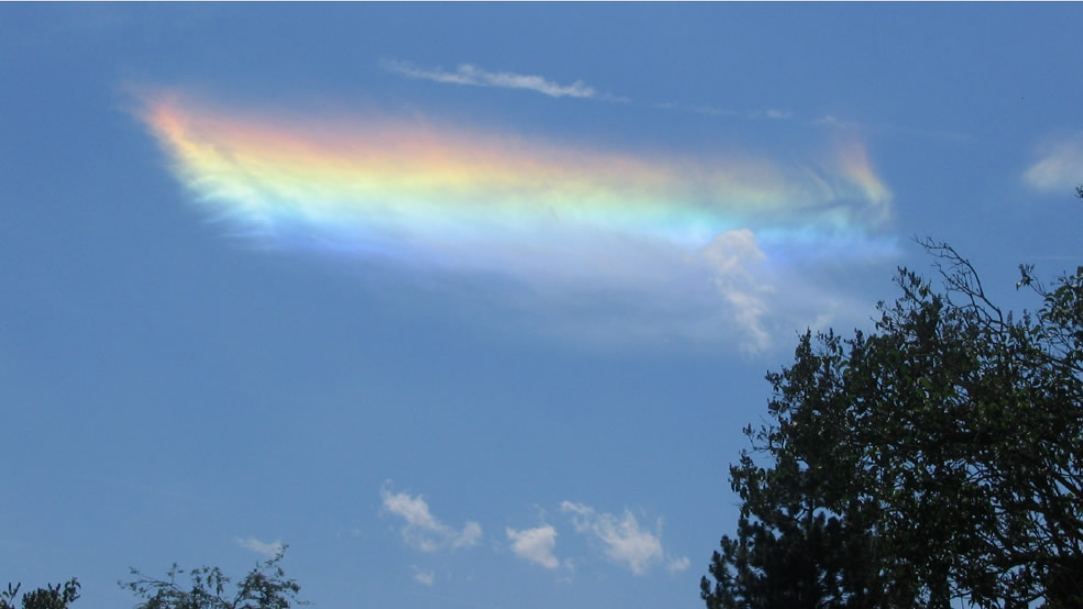Circumhorizon Arc, Switzerland
Circumhorizon Arc, Switzerland: A Spectacular Atmospheric Phenomenon
Have you ever looked up at the sky and witnessed a breathtaking display of colors and optical illusions? One such captivating phenomenon is the Circumhorizon Arc, a vibrant and awe-inspiring halo that graces the skies. While it may sound like something out of a fantasy novel, this mesmerizing arc can actually be observed in various locations around the world, including Switzerland.
The Circumhorizon Arc is a massive, colorful halo that appears in the sky when sunlight interacts with ice crystals in cirrus clouds. It is often seen as fragments due to the size and shape of the crystals within the cloud. These crystals, known as flat plate crystals, play a crucial role in creating the stunning optical effects that leave us spellbound.
In Switzerland, the Circumhorizon Arc has been captured in all its glory by numerous photographers, including the talented 12-year-old Josie Smith. On June 17th, 2007, Josie skillfully captured an image of this incredible atmospheric phenomenon. The photograph showcases the fragments of the arc alongside lower clouds, adding an extra layer of beauty to the already luminous halo.
To fully appreciate the wonder of the Circumhorizon Arc, it's essential to understand the science behind its formation. This captivating optical phenomenon occurs when sunlight passes through hexagonal ice crystals in cirrus clouds. These crystals act as prisms, refracting the sunlight and separating it into its component colors. The result is a breathtaking display of vibrant hues spanning the entire visible spectrum.
The conditions required for the formation of a Circumhorizon Arc are quite specific. Firstly, cirrus clouds must be present, as they contain the necessary flat plate crystals. Additionally, the sun must be relatively high in the sky, typically at an angle greater than 58 degrees from the horizon. Finally, the ice crystals within the cirrus clouds must be oriented horizontally to create the optimal conditions for light refraction.
When these conditions align, the Circumhorizon Arc manifests as a vivid band of colors stretching horizontally across the sky. Its appearance is often likened to a rainbow, but with distinct differences. Unlike rainbows, which form when sunlight is refracted and reflected by water droplets, the Circumhorizon Arc is a result of ice crystals interacting with sunlight.
The colors of the Circumhorizon Arc are typically more vibrant and intense than those of a rainbow. This is due to the fact that the ice crystals in cirrus clouds are larger than water droplets, allowing for greater dispersion of light. As a result, the arc displays a stunning array of colors, ranging from deep reds and oranges near the top to vibrant blues and purples towards the bottom.
To fully appreciate the Circumhorizon Arc, it's best to observe it during the warm summer months when the sun is higher in the sky. The arc can appear at any time of day, but it is most commonly observed during midday when the sun's angle is optimal for creating the halo effect. When viewed from the ground, the arc appears as a horizontal band stretching across the sky, often accompanied by other atmospheric phenomena such as cirrus clouds or lower cloud fragments.
In conclusion, the Circumhorizon Arc is a breathtaking atmospheric phenomenon that graces the skies of Switzerland and other parts of the world. Its vibrant colors and mesmerizing display captivate all who are fortunate enough to witness it. So, keep your eyes to the sky and be prepared to be amazed by the wonders that nature has in store for us.

Switzerland circumhorizon arc. Often we see fragments of this huge arc, limited by the size and shape of the cirrus cloud containing the flat plate crystals. This one was photographed by 12 year old Josie Smith on 17th June '07. Note the fragments of lower cloud in front of the luminous halo. Image ©Josie Smith, shown with permission.
Note: this article has been automatically converted from the old site and may not appear as intended. You can find the original article here.
Reference Atmospheric Optics
If you use any of the definitions, information, or data presented on Atmospheric Optics, please copy the link or reference below to properly credit us as the reference source. Thank you!
-
<a href="https://atoptics.co.uk/blog/circumhorizon-arc-switzerland/">Circumhorizon Arc, Switzerland</a>
-
"Circumhorizon Arc, Switzerland". Atmospheric Optics. Accessed on November 26, 2024. https://atoptics.co.uk/blog/circumhorizon-arc-switzerland/.
-
"Circumhorizon Arc, Switzerland". Atmospheric Optics, https://atoptics.co.uk/blog/circumhorizon-arc-switzerland/. Accessed 26 November, 2024
-
Circumhorizon Arc, Switzerland. Atmospheric Optics. Retrieved from https://atoptics.co.uk/blog/circumhorizon-arc-switzerland/.